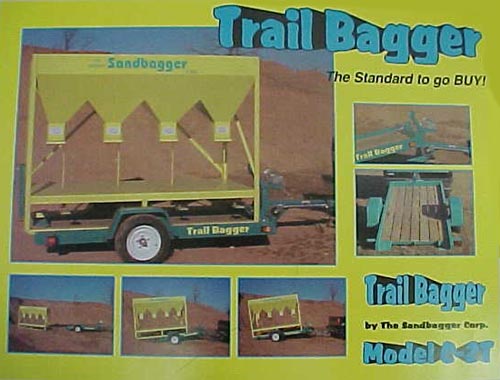Lake County's Emergency Equipment
We have a 22 foot trailer divided into 2 compartments. The rear compartment has equipment that is capable to communicate with all response agencies no matter what frequency. We also have telephone communications, fax capabilities and amateur radio equipment. The front compartment has a meeting area for incident commanders. It is heated and air conditioned and is powered by a generator. It can be taken to any location and set up within 15 minutes for operation. It is available for any community that requests its use.
We have a communications center with the capabilities to communicate with all emergency response agencies. It is equipped with ham radio equipment, an emergency alert system for notifying of impending situations which is computerized and can be remotely operated from anywhere.
The sandbagger can fill bags at the rate of 600 bags an hour. It is available for any community that has a need for it. It is motorized and can be taken anywhere.
We also have an E.O.C. (Emergency Operations Center) located in building next to our offices that has 8 computer stations for a representative from Red Cross, National Guard, State Highway, Lake County Government Building Manager, Lake County Public Works, NIPSCO, Lake County Highway and Lake County Sheriff.
In a major emergency, numerous agencies -- Federal, State and non-government -- must carry out the many different functions needed in an emergency swiftly and well. Many of these functions, as we have seen, are interdependent; one agency cannot do its job well without information from another agency it cannot directly "control".
The larger the number of responding agencies, the greater the resources, skills, data and potential confusion. These resources must be integrated and applied thoughtfully within a structure. That means across-the-board cooperation and information sharing. How can this be done efficiently when each agency and individual has so much to do just to get its task done -- without having to tell scores of agencies what it is doing and what it knows about the situation!
One proven way to improve coordination in a major emergency is by centralizing communications in an emergency operating center, or EOC.
An emergency operating center (EOC) is defined differently by various individuals and/or jurisdictions, due, in part, to the experiences of the individuals, threats to their jurisdictions, and other factors. In some jurisdictions, the EOC will be an extremely sophisticated facility, designed and built specifically for that purpose. In others, the EOC may be a converted conference room. In still others, no EOC exists.
In general, the major functions performed by the emergency management staff in the EOC include:
- Direction and control,
- Information collection, evaluation, and display,
- Coordination,
- Establishment of priorities, and
- Resource management
Across from the E.O.C., we have a large conference room. It holds up to 30 people. We use this for monthly meetings and in the event of a disaster it serves many purposes.


